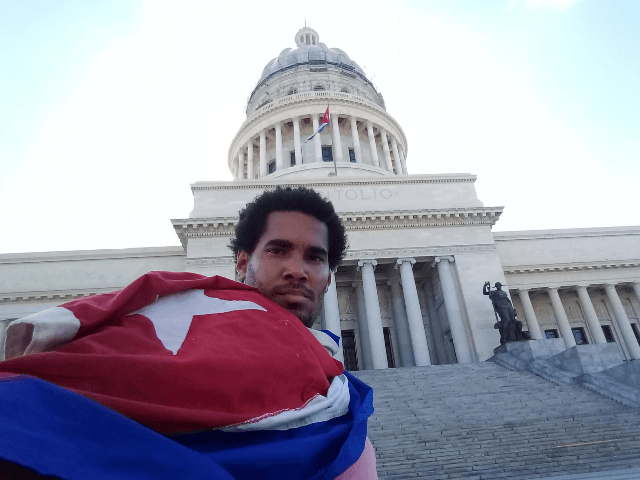Cuban police reportedly freed dissident artist Luis Manuel Otero Alcántara on Thursday afternoon after he went missing Monday shortly before the arrival of King Felipe VI of Spain and wife Queen Letizia.
Authorities appear at press time not to have charged him with anything, though they had reportedly threatened to legally detail him on charges of “public disorder.” They never elaborated on what behavior led to the threat of the charge and offered no legal reason to detain him.
The San Isidro Movement, the dissident coalition Otero founded, announced his release on Thursday, after international human rights groups pressured the regime to release him or offer him due process if charged with a crime.
The U.S.-based Martí Noticias reported that, three days into his detention, police would offer no explanation for why Otero was not free.
“They are going to investigate it and they have 72 hours to fine him, free him, or charge him,” Claudia Genlui Hidalgo, Otero’s girlfriend, said police officers told her on Wednesday. They suggested the artist may face charges of “public disorder,” but did not indicate what he had done to justify the charge.
Martí reported that Otero is facing charges of “aggravated disrespect,” a crime in Cuba, from last September.
Artists at Risk Connection (ARC) and PEN America, international organizations that advocate for free expression, issued a joint statement Wednesday urging Cuba to release Otero.
“In recent months, the artist has reportedly been detained arbitrarily on 14 different occasions. These recurrent attacks normalize injustice and show the lengths to which Cuban officials will go to silence dissent, terrorize artists, and limit freedom of expression.,” ARC director Julie Trébault said. “We call on the Cuban government to disclose Luis Manuel Otero Alcántara’s whereabouts and detention status and to release him immediately.”
The communist Cuban regime typically harasses dissidents into silence, imprisons them indefinitely, or otherwise “disappears” them when receiving special international guests. Major violent crackdowns on pro-democracy groups occurred during the visits of Pope Francis and former American President Barack Obama in recent memory.
King Felipe and Queen Letizia visited Havana – the first time the Spanish royals have done so in history – on the occasion of the 500th anniversary of the founding of Havana by Spaniards. The royals took photo ops in front of the oversized image of communist murderer Ernesto “Che” Guevara in the capital and Felipe reportedly paid a personal visit to dictator Raúl Castro on Thursday.
Spain’s foreign ministry told reporters that Spain “couldn’t not be there” on the anniversary of the founding of the city, despite the gruesome war for independence that Spanish creoles fought against their European brethren during the turn of the 20th century.
The visit by the king and queen of Spain appears to have had a similar effect, resulting in the mass arrests of members of the Ladies in White movement – a group of women dissidents whose sole act of protest is to attempt to attend Catholic Mass every Sunday before getting beaten and arrested. Also missing for over a month prior to the visit is the head of the largest dissident group in the country, the Patriotic Union of Cuba (UNPACU), José Daniel Ferrer.
Unlike those activists, Otero works as an artist, typically organizing dissident performances or expressive events to exist outside the sphere of communist influence. His disappearance occurred two days after the independent youth blog YUCAByte published an extensive profile of his work.
Among the various projects that Otero has spearheaded is the founding of the Museum of Dissidence in Cuba, intended to chronicle the fight of the martyrs that have died under the over 60 years of communist rule. In 2015, following the 2014 announcement by former President Obama that the United States would make concessions to the Castro regime, Otero walked the streets of Havana in a complete Tropicana showgirl outfit to represent the objectification of the Cuban people in the eyes of tourists who visited the island despite the intense repression against the native population.
Early this year, authorities arrested Otero for staging a footrace carrying American flags in Havana, an homage to dissident Daniel Llorente, beaten publicly and forced into a “mental health” facility for a year after interrupting the communist May Day parade by waving a U.S. flag. Llorente was forced into exile in Guyana this year and threatened with prison or death if he returned to his home country.
Otero also participated and led campaigns against Decree 349, a law that made it illegal to create an individual work of art without permission from the Castro regime.
Most recently, the San Isidro Movement launched a campaign called “The Flag Belongs to All,” a protest to a new series of laws limiting how Cubans could use or wear their own flag. The campaign featured a photo exhibit with images of Cubans around the world waving their flag.

COMMENTS
Please let us know if you're having issues with commenting.